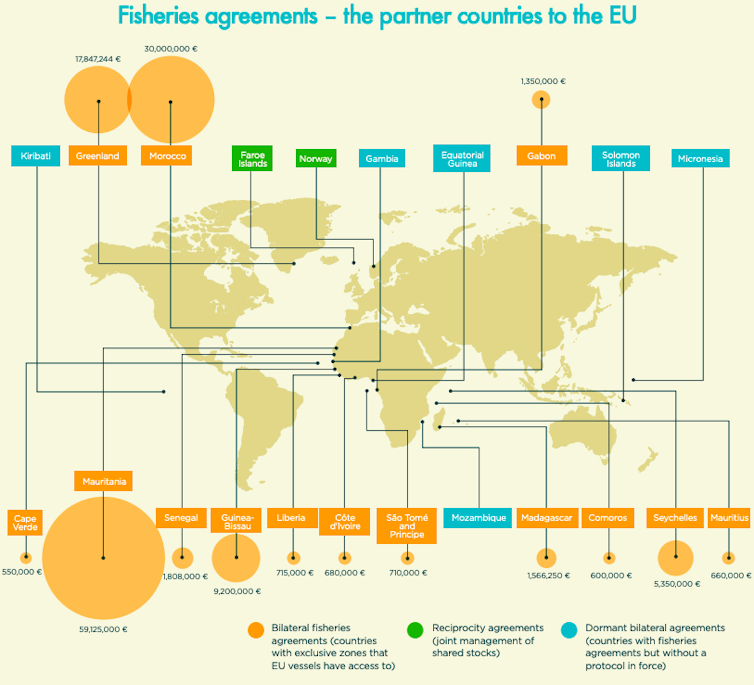The EU has a large fleet that fishes outside European waters. Nearly a third of its catch comes from non-EU waters, most of which belong to developing countries. Where and how much the EU’s “external fleet” can fish is set out in a number of agreements between member states and partner countries, and while these agreements are built on the idea of fairness and sustainability, in our new study we found that this is difficult to truly assess because of a lack of transparency.
UN law recognises the rights of coastal nations to control fish harvests within their national waters, a 200 nautical-mile limit from their coastline. These “exclusive economic zones” cover around 35% of the ocean, bringing about 90% of global fisheries under the control of coastal states. Since 1982, the only way a foreign nation can legally fish in the waters of a coastal nation is through specific fishery agreements between both parties.
The EU’s external fishing activities are also governed by the Common Fisheries Policy, structured around bilateral agreements known as sustainable fisheries partnership agreements – which countries use to give access to EU vessels – and multilateral agreements that control fishing on the high seas.
Alongside ensuring access to global fishing zones and resources, the aims of the Common Fisheries Policy include: contributing to the sustainable development of world fisheries; tackling destructive fishing practices; improving research and data; combating illegal, unregulated and unreported fishing; and strengthening control and inspections.

This story is part of Oceans 21
Our series on the global ocean opened with five in depth profiles. Look out for new articles on the state of our oceans in the lead up to the UN’s next climate conference, COP26. The series is brought to you by The Conversation’s international network.
To do this, the EU provides financial contributions and technical support to partner countries. The EU now regulates numerous such agreements with countries in east and west Africa, the Caribbean, the Pacific and the North Atlantic. In 2009, 14 non-EU countries were collectively paid nearly €150 million (£133 million), making the EU’s financial contributions substantial – and often the main source of revenue for the fisheries ministries of these countries.
And by keeping fishing within the resource limits of partner countries, involving all stakeholders, and contributing to the social and economic development of often less-developed partner countries, these agreements – in theory – are a major step in ensuring the sustainability of the EU’s fishing activities.
The flipside
Agreements have the potential to contribute to food security, economic growth and environmental and social resilience in partner countries. However, insufficient, inaccurate and non-public data makes it difficult to properly evaluate these contributions.
For example, partner countries may not be able to fish far offshore from a lack of local vessels that can reach distant fishing grounds. Although EU states paying for access to these otherwise inaccessible waters would appear to make good sense, it isn’t always fair and sustainable.
Take Senegal. Under EU fisheries agreements, the amount of fish caught between 1994 and 2005 fell from 95,000 to 45,000 tonnes due to the overexploitation of stocks. Locally-owned vessels also dropped by 48% between 1998 and 2008.
The EU’s agreement with Senegal was cancelled in 2006 after Senegal demanded additional compensation. But in 2014, another agreement (for tuna and hake) was concluded worth US$1.9 million (£1.4 million) annually, to be renewed every five years, with US$1 million earmarked to promote the sustainable management of Senegal’s fisheries.
Improved access to knowledge, markets, services and opportunities is also a potential benefit for partner countries. But although fish caught in other nations’s waters should be fished according to EU law, there have been numerous cases of illegal, unreported and unregulated fishing by EU vessels in non-EU waters.
Building in sustainable goals
Our new paper, published in Fish and Fisheries, is an attempt to evaluate the true sustainability of the EU’s external fleet by comparing it with the UN’s Sustainable Development Goals (SDGs), which include aims to end poverty, protect the planet and ensure that all people enjoy peace and prosperity by 2030.
While fishing and fisheries most directly relate to SDG 14, to “conserve and sustainably use the oceans”, we found many more goals where the EU external fleet implicitly interacts. Creating jobs from investments in production and helping to reduce poverty in partner countries, for example, aligns the goal to eliminate poverty (SDG 1), and the goal to provide decent work and economic growth (SGD 8). Other areas that relate to SDGs include health and safety regulations and social security (SDG 3) and the employment of millions of women in the fishing sector (SDG 5), though many are found in the informal economy or in marginalised roles in the supply chain
Improving the data
Our thinking was that EU fishing policy should explicitly engage with sustainable goals other than SDG 14, especially if the EU is to honour its commitment to achieving sustainability across the board by 2030. And we hoped that our research would help to better understand the relationship between EU policy and wider sustainable goals.
But what we discovered was a lack of open-access data and transparency from EU members states and partner countries, reducing their accountability and making it difficult to properly evaluate the true economic, social and environmental sustainability of these fishing activities.
Vessel operators and partner countries must better report data on catch, bycatch, vessel registrations, and labour conditions – and how EU funds are used within partner countries. Clearer, standardised systems for data collection, verification of third parties, and better technologies for monitoring and reporting is also certainly needed. If such improvements are not made, progress towards sustainable, accountable, transparent and fair external fishing practices will remain slow.
Although the external fleet is only a small part of the EU’s drive towards sustainability, equity and global leadership in fisheries, it has an important role to play in people’s lives and marine ecosystems around the world. Policy should be better integrated with efforts directly targeting SDGs on ocean health, social resilience and economic improvement. If the EU prioritises reporting on how its external fisheries specifically support these outcomes, as well as poverty reduction, gender equality, inclusion and human rights, it will go a long way to making sure that its commercial agreements are not just sustainable in name only.



 Asia’s IPO Market Set for Strong Growth as China and India Drive Investor Diversification
Asia’s IPO Market Set for Strong Growth as China and India Drive Investor Diversification  U.S. Black Friday Online Spending Surges to $8.6 Billion, Boosted by Mobile Shoppers
U.S. Black Friday Online Spending Surges to $8.6 Billion, Boosted by Mobile Shoppers  Airline Loyalty Programs Face New Uncertainty as Visa–Mastercard Fee Settlement Evolves
Airline Loyalty Programs Face New Uncertainty as Visa–Mastercard Fee Settlement Evolves  Morgan Stanley Boosts Nvidia and Broadcom Targets as AI Demand Surges
Morgan Stanley Boosts Nvidia and Broadcom Targets as AI Demand Surges  Bitcoin Defies Gravity Above $93K Despite Missing Retail FOMO – ETF Inflows Return & Whales Accumulate: Buy the Dip to $100K
Bitcoin Defies Gravity Above $93K Despite Missing Retail FOMO – ETF Inflows Return & Whales Accumulate: Buy the Dip to $100K  Ethereum Ignites: Fusaka Upgrade Unleashes 9× Scalability as ETH Holds Strong Above $3,100 – Bull Run Reloaded
Ethereum Ignites: Fusaka Upgrade Unleashes 9× Scalability as ETH Holds Strong Above $3,100 – Bull Run Reloaded 

































